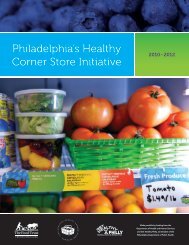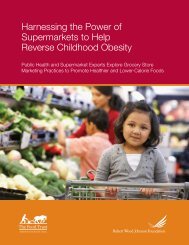The Grocery Gap: Who Has Access to Healthy - The Food Trust
The Grocery Gap: Who Has Access to Healthy - The Food Trust
The Grocery Gap: Who Has Access to Healthy - The Food Trust
You also want an ePaper? Increase the reach of your titles
YUMPU automatically turns print PDFs into web optimized ePapers that Google loves.
PolicyLink<strong>The</strong> <strong>Food</strong> <strong>Trust</strong>Executive SummaryAn apple a day?For millions of Americans—especially peopleliving in low-income communities of color—finding a fresh apple is not so easy. Full-servicegrocery s<strong>to</strong>res, farmers’ markets, and other vendorsthat sell fresh fruits, vegetables, and other healthyfoods cannot be found in their neighborhoods.What can be found, often in great abundance,are convenience s<strong>to</strong>res and fast food restaurantsthat mainly sell cheap, high-fat, high-sugar,processed foods and offer few healthy options.Without access <strong>to</strong> healthy foods, a nutritiousdiet and good health are out of reach. Andwithout grocery s<strong>to</strong>res and other freshfood retailers, communities are missing thecommercial hubs that make neighborhoodslivable, and help local economies thrive.For decades, community activists have organizedaround the lack of access <strong>to</strong> healthy foods asan economic, health, and social justice issue. Asconcerns grow over healthcare and the country’sworsening obesity epidemic, “food deserts” — areaswhere there is little or no access <strong>to</strong> healthy andaffordable food—have catapulted <strong>to</strong> the forefron<strong>to</strong>f public policy discussions. Policymakers atthe local, state, and national level have begunrecognizing the role that access <strong>to</strong> healthy foodplays in promoting healthy local economies,healthy neighborhoods, and healthy people.This report, a summary of our current knowledgeabout food deserts and their impacts oncommunities, provides evidence <strong>to</strong> inform thispolicymaking.To assess the current evidence base in thisdynamic and fast-growing field of research, wecompiled the most comprehensive bibliography<strong>to</strong> date of studies examining food access and itsimplications conducted in the United States overthe past 20 years. This bibliography incorporates a<strong>to</strong>tal of 132 studies: Sixty-one published in peerreviewedjournals and primarily conducted byuniversity-based researchers and 71 conductedby practitioners or policy researchers, sometimesin collaboration with academic researchers, andself-published (also known as “grey literature”).<strong>The</strong> studies include three nationwide analysesof food s<strong>to</strong>re availability and neighborhood,city, county, regional, statewide, and multistateanalyses covering 22 states across the country.Findings1. <strong>Access</strong>ing healthy food is a challengefor many Americans—particularly thoseliving in low-income neighborhoods,communities of color, and rural areas. Inhundreds of neighborhoods across the country,nutritious, affordable, and high quality foodis largely missing. Studies that measure foods<strong>to</strong>re availability and availability of healthy foodsin nearby s<strong>to</strong>res find major disparities in foodaccess by race and income and for low-density,rural areas.• Lack of supermarkets. A 2009 study bythe U.S. Department of Agriculture foundthat 23.5 million people lack access <strong>to</strong> asupermarket within a mile of their home.A recent multistate study found that lowincomecensus tracts had half as manysupermarkets as wealthy tracts. Anothermultistate study found that eight percen<strong>to</strong>f African Americans live in a tract with asupermarket, compared <strong>to</strong> 31 percent ofwhites. And a nationwide analysis foundthere are 418 rural “food desert” countieswhere all residents live more than 10 milesfrom a supermarket or supercenter—this is 20 percent of rural counties.7






